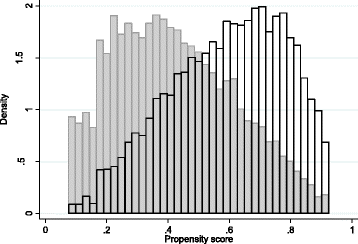Impact of the Bolsa Família program on food availability of low-income Brazilian families: a quasi experimental study
- PMID: 27538516
- PMCID: PMC4991072
- DOI: 10.1186/s12889-016-3486-y
Impact of the Bolsa Família program on food availability of low-income Brazilian families: a quasi experimental study
Abstract
Background: The Bolsa Família Program was created in Brazil in 2003, by the joint of different social programs aimed at poor or very poor families with focus on income transfer to promote immediate poverty relief, conditionalities and complementary programs. Given the contributions of conditional cash transfer programs to poverty alleviation and their potential effects on nutrition and health, the objective of this study was to assess the impact of the Bolsa Família Program on food purchases of low-income households in Brazil.
Methods: Representative data from the Household Budget Survey conducted in 2008-2009 were studied, with probabilistic sample of 55,970 households. 11,282 households were eligible for this study and 48.5 % were beneficiaries of the BFP. Food availability indicators were compared among paired blocks of households (n = 100), beneficiaries or non-beneficiaries of the Bolsa Família Program, with monthly per capita income up to R$ 210.00. Blocks of households were created based on the propensity score of each household to have beneficiaries and were homogeneous regarding potential confounding variables. The food availability indicators were weekly per capita expenditure and daily energy consumption, both calculated considering all food items and four food groups based on the extent and purpose of the industrial food processing. The comparisons between the beneficiaries and non-beneficiaries blocks of households were conducted through paired 't' tests.
Results: Compared to non-beneficiaries, the beneficiaries households had 6 % higher food expenditure (p = 0.015) and 9.4 % higher total energy availability (p = 0.010). It was found a 7.3 % higher expenditure on in natura or minimally processed foods and 10.4 % higher expenditure on culinary ingredients among the Bolsa Família Program families. No statistically significant differences were found regarding the expenditure and the availability of processed and ultra-processed food and drink products. In the in natura or minimally processed foods group, the expenditure and the availability of meat, tubers and vegetables were higher among the Bolsa Família Program beneficiaries.
Conclusion: The Bolsa Família Program impact on food availability among low-income families was higher food expenditure, higher availability of fresh foods and culinary ingredients, including those foods that increase diet's quality and diversity.
Keywords: Food availability; Income transfer; Propensity score.
Figures
Similar articles
-
The impact of Brazil's Bolsa Família conditional cash transfer program on children's health care utilization and health outcomes.BMC Int Health Hum Rights. 2014 Apr 1;14:10. doi: 10.1186/1472-698X-14-10. BMC Int Health Hum Rights. 2014. PMID: 24690131 Free PMC article.
-
Cash Transfers and Child and Adolescent Development.In: Bundy DAP, Silva ND, Horton S, Jamison DT, Patton GC, editors. Child and Adolescent Health and Development. 3rd edition. Washington (DC): The International Bank for Reconstruction and Development / The World Bank; 2017 Nov 20. Chapter 23. In: Bundy DAP, Silva ND, Horton S, Jamison DT, Patton GC, editors. Child and Adolescent Health and Development. 3rd edition. Washington (DC): The International Bank for Reconstruction and Development / The World Bank; 2017 Nov 20. Chapter 23. PMID: 30212143 Free Books & Documents. Review.
-
Changes in food consumption among the Programa Bolsa Família participant families in Brazil.Public Health Nutr. 2011 May;14(5):785-92. doi: 10.1017/S136898001000279X. Epub 2010 Dec 6. Public Health Nutr. 2011. PMID: 21129236
-
The impact of the Bolsa Família Program on food consumption: a comparative study of the southeast and northeast regions of Brazil.Cien Saude Colet. 2017 Jun;22(6):1771-1780. doi: 10.1590/1413-81232017226.25852016. Cien Saude Colet. 2017. PMID: 28614498 English, Portuguese.
-
The Brazilian cash transfer program (Bolsa Família): A tool for reducing inequalities and achieving social rights in Brazil.Glob Public Health. 2022 Jan;17(1):26-42. doi: 10.1080/17441692.2020.1850828. Epub 2020 Nov 30. Glob Public Health. 2022. PMID: 33253042 Review.
Cited by
-
Association between total available nutritional quality and food expenditure in Peruvian households, 2019-2020.Cad Saude Publica. 2023 Sep 18;39(9):e00021923. doi: 10.1590/0102-311XEN021923. eCollection 2023. Cad Saude Publica. 2023. PMID: 37729301 Free PMC article.
-
The impact of cash transfer participation on unhealthy consumption in Brazil.Health Policy Open. 2022 Dec 6;4:100087. doi: 10.1016/j.hpopen.2022.100087. eCollection 2023 Dec. Health Policy Open. 2022. PMID: 37383885 Free PMC article.
-
Effect of a conditional cash transfer programme on leprosy treatment adherence and cure in patients from the nationwide 100 Million Brazilian Cohort: a quasi-experimental study.Lancet Infect Dis. 2020 May;20(5):618-627. doi: 10.1016/S1473-3099(19)30624-3. Epub 2020 Feb 14. Lancet Infect Dis. 2020. PMID: 32066527 Free PMC article.
-
Fruit and vegetable consumption among Brazilian adults: trends from 2008 to 2023.Cad Saude Publica. 2025 Feb 7;41(1):e00032424. doi: 10.1590/0102-311XEN032424. eCollection 2025. Cad Saude Publica. 2025. PMID: 39936779 Free PMC article.
-
Prevalence of daily fruit and vegetable intake by socio-economic characteristics, women's empowerment, and climate zone: an ecological study in Latin American cities.J Nutr Sci. 2025 Jan 15;14:e4. doi: 10.1017/jns.2024.93. eCollection 2025. J Nutr Sci. 2025. PMID: 39943925 Free PMC article.
References
-
- Das J. Reassessing Conditional Cash Transfer Programs. World Bank Res Obs. 2005;20:57–80. doi: 10.1093/wbro/lki005. - DOI
-
- Barros RPCM, Franco S, Mendonça R. A queda recente da desigualdade de renda no Brasil. In: Barros RP, Foguel MN, Ulyssea G (organizadores). Desigualdade de renda no Brasil: uma análise da queda recente. Brasília: IPEA; 2007. pp. 108–110.
-
- Hoffman R. Desigualdade da renda e das despesas per capita no Brasil, em 2002-2003 e 2008-2009, e avaliação do grau de progressividade ou regressividade de parcelas da renda familiar. Econ Soc. 2010;19:647–61. doi: 10.1590/S0104-06182010000300010. - DOI
MeSH terms
LinkOut - more resources
Full Text Sources
Other Literature Sources


